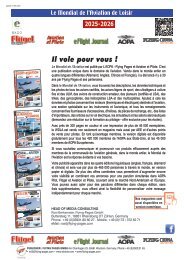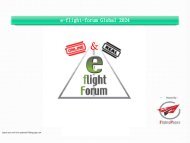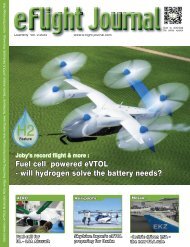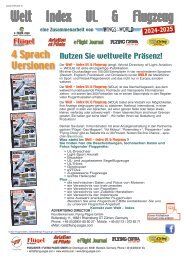eFlight Journal 02-2020
E-Flight Journal 2-2020
E-Flight Journal 2-2020
- No tags were found...
Create successful ePaper yourself
Turn your PDF publications into a flip-book with our unique Google optimized e-Paper software.
Cover Market Story Watch<br />
1 2<br />
SPEEDS AND STALLS<br />
The stall speed of the 600 kg plane is approx. 75 km / h.<br />
This is about 10 km / h faster than the lightest Phoenix<br />
version, the 472.5 kg version, which met the 65 km / h of<br />
the old UL regulations.<br />
The top speed measurement with the Phenix is a bit difficult.<br />
“In its current configuration, the temperature of the<br />
motor rises continuously above the ideal temperature<br />
with continuous output of over 34 kw,” explains Martin.<br />
“You can fly for 5 minutes with a full 60 kw of power, as<br />
we saw in the attempts to tow gliders, but the temperature<br />
then rises continuously. We are working on it and the<br />
next version of MGM Compro already has better cooling.”<br />
The Rotax eMotor used is designed as an out runner;<br />
the rotating outer rotor is cooled with air, the stator in<br />
the middle with liquid.<br />
At 30 kw power we fly in a triangle via GPS just over 160<br />
km / h. At 34 Kw you do not quite reach the 180 km / h at<br />
which the green area ends at the speedometer. The aircraft<br />
has a VNE of 242 km / h.<br />
The best cruising speed of the E- version is 120 km / h,<br />
the motor consumes 11 Kw, i.e. with the current battery<br />
with 35 Kw you can theoretically stay in the air for 3 hours<br />
without thermals if the additional 2 Km / h are sufficient<br />
for the start. “But I’ve already flown two or two and a half<br />
hours several times,” says Martin.<br />
We choose 120 km / h, no flaps and pull on the stick. The<br />
nose rises more and more steeply into the sky. At a little<br />
over 70 km / h on the speedometer, the rudders first become<br />
soft, then the machine nods to the right. But the<br />
wings automatically level themselves out when the stick<br />
releases, without the need for a rudder input. Now we<br />
do the same without engine power. Instead of just nodding<br />
over the nose as I expected, the machine now turns<br />
left. While I’m still thinking loudly about a technical cause<br />
in the headset, Martin grins at me and points to himself.<br />
“Very simple: weight and balance. I am the reason: my<br />
over 110 kilos to your 82, it is clear in which direction the<br />
plane is leaning. ”A few more handling tests, then we are<br />
back to the runway.<br />
We have reduced our altitude until the approach. We set<br />
the flaps first on 5 then - in cross approach - to 10 degrees<br />
- maximum position. As we turn to the runway axis,<br />
we are still quite high. We set the power to zero and the<br />
propeller to the start position, but we are still a bit high.<br />
That´s because with its best glide of over 1:30 the Phenix<br />
slowly degrades at 100 km / h. But it not only has wings<br />
like a glider, it also has air brakes. Just keep speed, pull<br />
the brakes until the height fits. At the threshold we begin<br />
to float, make a two-point landing and hold the tail up until<br />
it settles on its own.<br />
The view is restricted, as it is usual with a tail wheel plane.<br />
But with the fact that the instrument panel on the sides is<br />
shifted far down it enables the track to be seen quite well.<br />
We roll back. Despite our 45-minute flight there is still<br />
enough energy in the battery for the photo flight so that<br />
I can switch to the Alpha plane and we immediately take<br />
off again.<br />
HISTORY<br />
From the start, Martin Stephanek designed his Phoenix<br />
for 600 kilograms. “The Rotax version too,” says Martin,<br />
“because I was sure that it would come. We had<br />
the ELSA class in the Czech Republic for several years,<br />
which allowed aircraft weighing up to 600 kilograms. In<br />
other countries, such as the USA, the machines fly as<br />
“experimental” motor gliders.”<br />
Right from the start, Stephanek thought of an electric version,<br />
so the 600 kg was indispensable. “We planned the<br />
first version in 2011 for the NASA Cafe Challenge, which<br />
Pipistrel then won. Our Electra 1 had an electric motor<br />
with a special cowling retractable landing gear, variable<br />
pitch propeller so that we could meet the requirements<br />
of 160 km / h cruising speed, with modified wings based<br />
on those of the glider Discus. The performance was impressive,<br />
but unfortunately the machine was not able to<br />
compete. Therefore, the former kite flying champion and<br />
US importer from Phoenix Air took part in the challenge<br />
with the version with combustion engine and discus sur-<br />
50 e Flight <strong>Journal</strong><br />
2 / 2<strong>02</strong>0
















